The invention of printing has made one of the greatest contributions to cultural and technological progress in the world over the centuries.
Various books about printing, a product of Chinese wisdom, were written both inside and outside China, namely The Invention and Influence of Chinese Typography by Zhang Xiumin and Concerning the Origins of Engraved Plate by Sun Xuxiu. Both of these are internationally recognized works. There are still some doubts, however, as to when printing with engraved plates began. Perhaps this question can best be answered by examining the date at which the oldest known book still in existence in the world was printed. There are several opinions about this. Some scholars claim that printed material appeared as early as the Sui Dynasty (581-681). I discussed this theory in my book The Invention of Printing with Engraved Plates in China. Other scholars claim that there are references to printing in the early Tang Dynasty, that is, in the Ⅶth century.
As far as I know, an academic study of the material which is available has still not been made. In this article I shall attempt to put together some of the notes I have made from reading ancient classical texts leaving the contents open to criticism and comments.
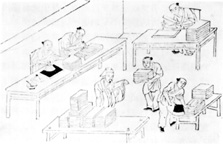 A Chinese drawing showing the various steps in xylographic printing and book-binding taken from an ancient Chinese book belonging to the author, in José Maria Braga, Primórdios da Imprensa em Macau.
A Chinese drawing showing the various steps in xylographic printing and book-binding taken from an ancient Chinese book belonging to the author, in José Maria Braga, Primórdios da Imprensa em Macau.
In The Invention and Influence of Chinese Typography, Zhang Xiumin bases his argument on a passage from volume 46 of Hingjianlu (by Shao Jingbang) in order to arrive at the following conclusion: Chinese typography using engraved plates was probably invented at the beginning of the Ⅶth century. Although the author wisely qualified his work with a "probably", several books were written based on the theory that Nuze (Examples of Women) was the first book to be printed using engraved plates in China. In order for us to arrive at an informed judgement, it is helpful to take a look at the relevant passage from the Hongjianlu:
"Chang Sun, the wife of Emperor Tangtaizong, died when she was thirty six years old. The emperor was most concerned when the book Nuze, an original manuscript consisting of ten chapters was given to him. The book, written by Chang Sun, was a collection of commentaries on the virtues of ancient women and a criticism of the ways in which the relations of the Emperor's wife and mother interfered in politics during the Han Dynasty. Chang Sun regarded the behaviour of Empress Ma during this dynasty as less than commendable for, while she renounced the use of her opulent carriages, she avoided basic problems as she was incapable of solving them. The sovereign was so impressed with the contents of the book that, in a voice full of praise, he ordered the manuscript to be printed using engraved plates so that it could be dedicated to posterity."
In Zhu Zhai Du Shu Sui Bi Hui Bian, volume 12 (Zakao / Informal Studies), the author, Zheng Jishi, writing in the Qing Dynasty included a transcription of the same extract from Hongjianlu and concluded by saying: "It is obvious that Chinese printing using engraved plates began at that time".
It is believed that Shao Jingbang passed the imperial examinations in 1521, during the sixteenth year in the Reign of Zheng De. His book, Hongjianlu, was simply a collection of notes which he had made from the Histories of the Tang, Wudai, Song, Liao and Jin Dynasties. First we must ask where he found the reference to Empress Chang Sun, wife of Emperor Tangtaizong as it differs from a number of other references which are available. We have only to look a little further to find the nub of the question.
Let us look first at volume 51 of the Ancient Book of Tang where the life of Empress Chang Sun is discussed: "She died at the age of thirty six in June 636. Her book, Nuze, written in ten chapters discusses the virtues of women. She also wrote the introduction to the book where she commented on the behaviour of Empress Ma of the Han Dynasty concerning the interference of the Emperor's wife's and mother's relatives in politics. Seeing that she was unable to do anything to remedy the situation, she surrendered her personal means of transport, in the hope that she was setting an example for the nobility. After Empress Chang Sun died, the Emperor read the book and in his grief told the ministers around him: "The work of the Empress must be kept for posterity. This request is not made because of some incontrollable emotion. I know that she was destined to die at this age."
Let us now look at volume 76 of the New Book of Tang: Empress Chang Sun died when she was thirty six. She wrote Nuze, a ten-chapter book about women in ancient times. She also criticized the attitudes of Empress Ma of the Han Dynasty in connection with the interference of members of the Emperor's mother's and wife's family, for giving up the use of her own means of transport in order to avoid facing the real problems which were present... After Chang Sun's death, the Emperor was told that she had left a book and when he read it he felt even greater pain and told the ministers around him: "The Empress' book must be kept for posterity. And this does not mean that I cannot control myself. I know she was destined to die at this age."
Volume 194 of Zi Zhi Tong Jian (General Lessons on Domination) contains similar references to Nuze: Empress Chang Sun tried to collect good and bad examples of ancient women to write the book Nuze. She also tried to criticize the attitudes of Empress Ma of the Han Dynasty as regards the involvement in political affairs of members of the Emperor's wife's and mother's family... After Chang Sun's death, the Emperor was told of the existence of the book and when he read it he felt even greater pain. He then said in an aside to the ministers that the book should "be left to posterity. Not because I don't know that this was her fate, but because I have lost an adviser who could give me good counsel. On no account can I forget this".
We may conclude from the three transcriptions containing Shao Jingbang's quotation that:
1. The reference to Empress Chang Sun in Hongjianlu has its origins in these three historical documents where the stories are obviously very similar to the extent that some of the phrasing is even identical.
2. According to official historical records, the. chroniclers Liu Xu, Ouyang Xiu, Song Qi and Sima Guang who predated Shao Jingbang by several hundred years, had no knowledge that Nuze was a book printed at the command of Emperor Tangtaizong.
3. How, then, could Xhao Jingbang, who simply copied the documents, have known about it? It seems clear that it was a figment of his imagination, that it simply was not true.
 Wu Guo Guang Da Tuo Luo Ni Jing, held in Fuguo Temple in Qingzhou, Korea. Printed in 751, the book is the oldest known example of xylographic printing.
Wu Guo Guang Da Tuo Luo Ni Jing, held in Fuguo Temple in Qingzhou, Korea. Printed in 751, the book is the oldest known example of xylographic printing.
Without having solid ground for doing so, Zheng Jishi placed his faith in Shao Jingbang's statement and maintained that Nuze was printed on engraved plates. This is absurd! If Emperor Tangtaizong had ordered a thirty volume work like Nuze to be printed using engraved plates (Lui Xu said there were ten volumes and Ouyang Xu referred to ten chapters), this would undoubtedly have been a sufficiently important event in the Court to have been recorded and praised. The fact is that there is no reference at all to this in any of the existing historical documents. In fact it is surprising that there should be a reference to Nuze in Hongjianlu which was written by Shao Jingbang in the Ming Dynasty (1368-1644).
In Volume 35 of Tanghuiyao by Wangfu there is a reference to the fact that all works in the Tang Court at the time were copied by hand at the beginning of the dynasty. This proves once more that there was no plate printing at this time. In May 719, an imperial edict decreed that work should begin on "copying old books dating from before Emperors Taizong and Gaozong" and that "any gaps should be filled in" at the same time. In the winter of 731, all written works were classified. At this time, books dating from the Liang, Chan, Qi, Zhou (from the Dynasty of the South and the North), books from the Sui Dynasty and the time of the Emperors Zhenguan (627-649) and Yinghui (650-655) were "copied by imperial decree". These sources reveal no mention of xylographic printing in the imperial Court.
Additional proof of the existence of printing by hand during Tangtaizong's reign is evident in the frequent references such as "In Yun Xian San Ji, written by Feng Ji in the Tang Dynasty it is said the Xuan Zang (a monk) printed portraits of Samantabhadra on Huifengzi paper to hand out to all those who passed. Five beasts were required to transport them each year."
In fact, and according to Tan Song Cong Shu (Collections of Tang and Song), the authenticity of Yun Xian San Ji was doubtful. The issue is clearer in Siu Ku Quan Shu Zong Mu Ti Yao (General Catalogue of the Complete Works of the Four Species): the work had a previous title, Jin Cheng Feng Zhi Zhuan, but the author was unknown. It was a record of old anecdotes, but not only do the titles of the books quoted fail to appear in historical documents, it is also full of historical inaccuracies.
In his Shu Lu Jie Ti, Chen Zhensun states that the so-called Feng Zhi did not exist. Hong Mai, of the Song Dynasty, in his Rong Zhai Sui Bi, and Zhao Yushi in Tui Biu Lu are of the same opinion. Zhang Bangji of the Song Dynasty, in the Mo Zhuang Man Lu claimed that: "Recently, a book called Long Chen Lu appeared, another fake work by Wang Xing, the author of Yuan Xian San Lu which is a completely absurd book. What is more, a so-called Li Xie signs himself as the author of explanatory notes to poems by Du Fu and Dong Po. In fact it is the same Wang Xing. What a stupid thing to do!"
At the beginning of the Tang Dynasty, the bonze Yi Jing wrote Nan Hai Ji Gui Nei Fa Zhuan. In volume four of this work he says: "They make clay plaques engraved with images of Buddha and use them to stamp on pieces of silk so that they may be worshipped anywhere, in pagodas or in the country. This is how the Hindu Buddhists spread Buddhism." Based on this information, Fujitatoyoya stated in his "Origins of Chinese Printing" that printing with engraved plates had originated in India and not in China.
However, this is propbably not the case. Wooden seals dating from the Tang Dynasty discovered in Ku She and moulds with the image of Buddha from the same period found in the caves at Dunhuang and Turfan are, in fact, nothing more than seals.
What must be established is the difference between tabular printing and the creation of seals and stamps. This is not only because the carving styles are different but also because different conditions are required and the results are different. Moreover, it seems that the first seals date from the Zhou Dynasty (c.11th century B. C.) during which time the hufu** came to be used. This was a kind of wooden, bamboo, bronze or jade seal which could be divided into two with one part remaining in the Court while the other was carried by officials on missions or by generals in wars during the Han Dynasty (206B. C. - 220A. D.). Qingnifengyin (a kind of seal) were also produced, and in the Tang Dynasty "emperor's seals" were used.
"Printing originated from imperial seals" wrote Luo Zhenyue in one of his books, also making the mistake of confusing printing with seals.
In the classic works there are several references to engraving seals to authenticate documents and for other uses. For example, in volume 17 of the Dao Po Zi Nei Bian, there is a description of a seal "12cm square with one hundred and twenty characters engraved on it". According to the Sui book Record of Rituals, the Du She Wan Ji seal was made of wood, around 40cm long and 8.25cm wide. All of these seals had been produced hundreds of years before the engraved images of the Buddhas, which were introduced into China from Eastern India. The mistake lies in an incorrect interpretation of the character Yin which means "to stamp" or "to print".
The document with the most pertinent reference to the existence of xylographic printing in China is the "Memorandum to Prohibit the Manual Printing of Calendars" which Feng Su presented to the Emperor during the Tang Dynasty. This document appears in the History of the Complete Tang Dynasty, Volume 64: "I most respectfully beg Your Majesty to consider this request to prohibit the printing of calendars. In Yuchuan, Jiannan and Huinan Prefectures, calendars are commonly printed by hand for sale to the public. Prior to the Meteorological and Astronomical Services asking permission from your Majesty to publish the new calendars, the others are already being sold on the street everywhere, and this is disrespectful to the divine power."
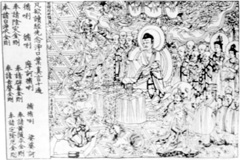
The frontispiece of Jing Gang Jing, engraved and printed in the 9th year of the reign of Xian Tong (A. D. 868) in the Tang Dynasty.
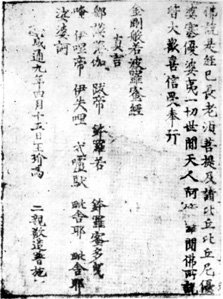
Jing Gang Jing, the last page.
The central Tang government proclaimed that printing illegal calendars was forbidden in order to ensure that the emperor had exclusive rights to authorize their publication.
In volume 17 of the Old Tang Book, Records of Emperor Wenzong, it is said that: "In December, 839, an imperial order was sent to the local governments prohibiting the manual printing of calendars".
This is the earliest proof of the existence of manual printing (of calendars) found in Chinese historical documents.
From that point on, several kinds of printed material began to appear. However, the quality was poor because the ink and the printing methods were of a very rudimentary nature. Jia Xun Xu, written by Liu Pin, states that: "It was the Summer of 883. whilst with Xun Xiu who was accompanying the Emperor on the three-year visit to Sichuan, I had the opportunity to read some books to the Southeast of Chongheng. They were books about Yin and Yang, geomancy and fortune-telling, but most of them were the illegal product of manual printing."
Similar references can also be found in the Ancient History of the Five Dynasties. In the Jia Liao Za Ji, Zhu Yi claimed that: "There was no manual printing before the Tang Dynasty." This seems to be fairly reasonable, but what, then, is the definite point at which xylographic printing appeared?
This can only be answered by studying the new historical documents and printed material which is being discovered.
In the meantime, it is not wise to elaborate opinions or theories on the basis of mistaken or fake books and records, or ungrounded conclusions such as that the origin of printing lies in the art of engraving seals.
There are only three basic texts in the whole world which are known of today indicating an approximate starting date for xylographic printing.
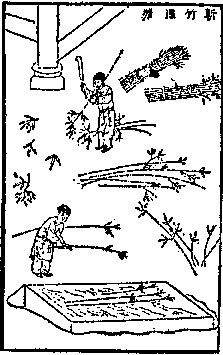
Soaking bamboo pulp to make paper-an illustration from Tian Gong Kai Wu.
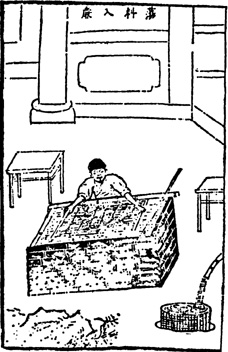
Cutting and crushing bamboo in a special tank-an illustration from Tian Gong Kai Wu by Song Yingxing,1637.
1. Jin Gang Jing, a scroll printed in 868, the ninth year of Emperor Xiantong's reign. This is the only illustrated book printed with engraved plates and it is still in a reasonable condition. It is 462cm long when stretched out, with six pages of text narrating the mystic stories which Sakyamuni told his disciples. At the end there are the words: "Wang Jie dedicated it to Erqin on the 15th of April, 868". This book was discovered in 1900 in the "Cave of the Sutras" in Mo Gao Kong, Dunhuang. In 1907 the Hungarian Mark Aurel Stein (a British citizen) stole three thousand scrolls from the caves at Dunhuang. They were engraved on thin plates of wood or bamboo. Stein used this material as the basis for his Archeology in the Western Region and mention of the book is made in Chapter XIII, entitled 'Discoveries in the Secret Chamber'. The original is now held in the British Museum and may truly be considered as a 'jewel' in the history of mankind.
2. Wu Goa Jing Guang Da Tuo Luo Ni Jing dated 770 is a collection of Buddhist practices intended for the use of Empress Seitoko in her old age. Each page is eighteen inches long and two inches wide giving thirty five lines to the page and five characters to the line.
There are copies in the Horyu Temple in Okurasho, the British Museum and the Leipzig Museum. The Hindu text was translated into Chinese by Fazang and Mi Tuoshan and was printed in Changan (the then capital of the Tang Dynasty) in 704. The book must have been taken to Japan later on when Buddhism was flourishing in the country. The priest Kenai studied in China for nineteen years and returned to his country with five thousand sutra scrolls and many images of Buddha. In Nestorianism in China - A Study of the Stone Inscriptions, Japanese scholars confessed that: "Between the Ⅶth and the XIIIth centuries, almost everything from Changan was copied in Kyoto... We can thus deduce that Buddhism most probably came from China ".
In 863, the Japanese prince Shinnyo went to China where he stayed for three years accompanied by the monk Takaaki (one of the eight monks who visited China during the Tang Dynasty). He returned home with all one hundred and forty three volumes of the Jing Lu Cao Shu. There are references to three Chinese printed books in Song Ri Xin Shu Xie Qing Lai Fa Men Deng Mo Lu. They are as follows: Jia Chi Zun Sheng Bing Da Bei Zhen Yan Ji Da Fu Ding Zhen Yan (three volumes), Tang Yun (five volumes) and Yu Bian (thirty volumes).
There can be no doubt that Chinese printing was introduced into Japan. Given that the above-mentioned book of Buddhist practices was printed in 770, we can deduce that printing by hand was invented prior to that date. Moreover, before Jin Gang Jing was printed in 868, the xylographic printing of texts was already widespread including literary works as well as sutras.
3. Wu Gou Jing Guang Da Tuo Luo Ni Jing, held in Fuguo Temple in Qingzhou, Korea (the capital from 668 to 935 A. D.). This book was printed in 751 and is the same as the sutra printed in Japan in 770.
The twenty-year gap can be explained by the following historical situation. The stone pagoda built in Qingzhou in honour of Sakyamuni was finished in 751 and it seems to have been inadmissible for the scroll to have been printed after this date. This is the oldest known product of hand printing in the world.
The sutra scroll was printed on mulberry paper and wound round a bamboo rod which was painted at each end. The text is 630cm long and 6cm wide and is printed on twelve strips of wood, each one measuring around twenty or twenty one inches.
The sutra may have been printed in Korea as the craft of printing by hand had been introduced from China. Later on, it arrived in Nara, either from Korea or from China, where it was reprinted.
L. C. Coodrich, a professor at Colombia University and a famous specialist in the history of printing, published "Printing: A Preliminary Report on a New Discovery" in which he maintained that the discovery of the sutra scroll was of great significance in tracing the history of printing.
It is worth noting that Qian Cunxun, the Director of the Far East Library of the University of Chicago, was the first to inform Hu Daojing of the discovery of the book in Korea. Hu Daojing, a Chinese scholar, immediately published an article entitled "The Discovery of the Oldest Printed Work in the World" in a literary magazine. He Yuling then translated Coodrich's text into Chinese with explanatory notes by Hu Daojing. Since then, several other articles have been published supporting this theory and thus focusing more attention on this important aspect of Chinese culture.
In concluding this short examination of the invention of manual printing in China, it seems to be a reasonable supposition to assume that the Chinese craft of printing had come into existence by at least the fourth decade of the Ⅷth century.
Translated from the Portuguese by Marie Imelda Macleod
**See the reference to "hufu" in "The Art of Chinese Seal Carving", Review of Culture No5, pp. 76-81.
*History lecturer in Yunnan University, a specialist on the History of Printing in China and author of several books on this subject.
start p. 18
end p.